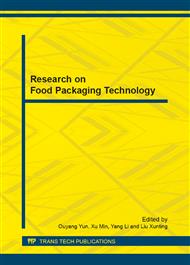[1]
Gonzalez, A., M. Cristina Strumia and C. I. Alvarez Igarzabal, 2011 Cross-linked soy protein as material for biodegradable films: Synthesis, characterization and biodegradation", "Journal of Food Engineering, Vol. 106, No. 4, pp.331-338.
DOI: 10.1016/j.jfoodeng.2011.05.030
Google Scholar
[2]
Han, J., S. Bourgeois and M. Lacroix, 2009 Protein-based coatings on peanut to minimise oil migration", "Food Chemistry, Vol. 115, No. 2, pp.462-468.
DOI: 10.1016/j.foodchem.2008.12.030
Google Scholar
[3]
Lodha, P. and A. N. Netravali, 2005 Characterization of Phytagel (R) modified soy protein isolate resin and unidirectional flax yarn reinforced "green" composites", "Polymer Composites, Vol. 26, No. 5, pp.647-659.
DOI: 10.1002/pc.20128
Google Scholar
[4]
Mauri, A. N. and M. C. Anon, 2008 Mechanical and physical properties of soy protein films with pH-modified microstructures", "Food Science and Technology International, Vol. 14, No. 2, pp.119-125.
DOI: 10.1177/1082013208092130
Google Scholar
[5]
Nayak, P., A. Sasmal, P. K. Nanda, P. L. Nayak, J. Kim and Y. W. Chang, 2008 Preparation and characterization of edible films based on soy protein isolate-fatty acid blends", "Polymer-Plastics Technology and Engineering, Vol. 47, No. 5, pp.466-472.
DOI: 10.1080/03602550801949728
Google Scholar
[6]
Ou, S. Y., K. C. Kwok and Y. J. Kang, 2004 Changes in in vitro digestibility and available lysine of soy protein isolate after formation of film", "Journal of Food Engineering, Vol. 64, No. 3, pp.301-305.
DOI: 10.1016/j.jfoodeng.2003.10.013
Google Scholar
[7]
Rhim, J. W., A. Gennadios, A. Handa, C. L. Weller and M. A. Hanna, 2000 Solubility, tensile, and color properties of modified soy protein isolate films", "Journal of Agricultural and Food Chemistry, Vol. 48, No. 10, pp.4937-4941.
DOI: 10.1021/jf0005418
Google Scholar
[8]
Rhim, J. W. and J. H. Lee, 2004 Effect of CaCl2 treatment on mechanical and moisture barrier properties of sodium alginate and soy protein-based films", "Food Science and Biotechnology, Vol. 13, No. 6, pp.728-732.
Google Scholar
[9]
Shon, J., J. H. Eo and J. B. Eun, 2010 EFFECT OF SOY PROTEIN ISOLATE COATING ON QUALITY ATTRIBUTES OF CUT RAW HAN-WOO (KOREAN COW) BEEF, AEROBICALLY PACKAGED AND HELD REFRIGERATED", "Journal of Food Quality, Vol. 2, No. 33, pp.42-60.
DOI: 10.1111/j.1745-4557.2010.00332.x
Google Scholar
[10]
Song, F., D. L. Tang, X. L. Wang and Y. Z. Wang, 2011 Biodegradable Soy Protein Isolate-Based Materials: A Review", "Biomacromolecules, Vol. 12, No. 10, pp.3369-3380.
DOI: 10.1021/bm200904x
Google Scholar
[11]
Su, J. -F., Z. Huang, X. Y. Yuan, X. Y. Wang and M. Li, 2010 Structure and properties of carboxymethyl cellulose/soy protein isolate blend edible films crosslinked by Maillard reactions", "Carbohydrate Polymers, Vol. 79, No. 1, pp.145-153.
DOI: 10.1016/j.carbpol.2009.07.035
Google Scholar
[12]
Su, J. -F., Z. Huang, Y. H. Zhao, X. Y. Yuan, X. Y. Wang and M. Li, 2010 Moisture sorption and water vapor permeability of soy protein isolate/poly(vinyl alcohol)/glycerol blend films", "Industrial Crops and Products, Vol. 31, No. 2, pp.266-276.
DOI: 10.1016/j.indcrop.2009.11.010
Google Scholar
[13]
Yin, S. -W., C. H. Tang, Q. B. Wen, and X. Q. Yang, 2007 Properties of cast films from hemp (Cannabis sativa L. ) and soy protein isolates", "A comparative study. Journal of Agricultural and Food Chemistry, Vol. 55, No. 18, pp.7399-7404.
DOI: 10.1021/jf071117a
Google Scholar
[14]
Wang, Z., Zhou, J., Wang, X. -X., Zhang, N., Sun, X. -X., and Ma Z. -S. Submitted to Food Hydrocolloids, (2013).
Google Scholar


